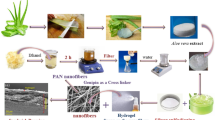Abstract
In recent years, nanofibers have been developed and widely used in many products, such as cosmetics and medical supplies. They can be fabricated from various synthetic or natural polymers and attached to bioactive compounds. In previous research, polycaprolactone (PCL) nanofibers containing Spirulina extract were demonstrated to be effective on dermal wound healing in a rat model. In this study, we fabricated Spirulina extract-alginate PCL nanofibers using alginate, which has hydrophilic structures capable of holding large amounts of water, to support the backbone of the nanofibers. The morphological characteristics, hydrophilicity, water absorbance, skin adhesiveness, toxicity to human keratinocyte cells (HaCaT), and Spirulina extract emission over time were assessed. Alginate improved the efficacy of Spirulina PCL nanofibers in moisture maintenance and adhesion ability, which highly affected recovery in the rat skin wound model. In conclusion, Spirulina extract-alginate PCL nanofibers could be considered a promising candidate for wound care.
Similar content being viewed by others
References
Shroff, A., A. Mamalis, and J. Jagdeo (2014) Oxidative stress and skin fibrosis. Curr. Pathobiol. Rep. 2: 257–267.
Kokabi, M., M. Sirousazar, and Z. M. Hassan (2007) PVA–clay nanocomposite hydrogels for wound dressing. Eur. Polym. J. 43: 773–781.
Lin, F. H., T. M. Chen, K. S. Chen, T. H. Wu, and C. C. Chen (2000) An animal study of a novel tri-layer wound dressing material-non-woven fabric grafted with N-isopropyl acrylamide and gelatin. Mater. Chem. Phys. 64: 189–195.
Khil, M. S., D. I. Cha, H. Y. Kim, I. S. Kim, and N. Bhattarai (2003) Electrospun nanofibrous polyurethane membrane as wound dressing. Biomed. Mater. Res. B. Appl. Biomater. 67: 675–679.
Zhou, Y., D. Yang, X. Chen, Q. Xu, F. Lu, and J. Nie (2007) Electrospun water-soluble carboxyethyl chitosan/poly (vinyl alcohol) nanofibrous membrane as potential wound dressing for skin regeneration. Biomacromol. 9: 349–354.
Ozdemir, G., N. Ulku Karabay, M. C. Dalay, and B. Pazarbasi (2004) Antibacterial activity of volatile component and various extracts of Spirulina platensis. Phytother. Res. 18: 754–757.
Wang, L., B. Pan, J. Sheng, J. Xu, and Q. Hu (2007) Antioxidant activity of Spirulina platensis extracts by supercritical carbon dioxide extraction. Food Chem. 105: 36–41.
Jung, S. M., S. K. Min, H. C. Lee, Y. S. Kwon, M. H. Jung, and H. S. Shin (2016) Spirulina-PCL nanofiber wound dressing to improve cutaneous wound healing by enhancing antioxidative mechanism. J. Nanomater. 2016: 24.
Syarina, P. N. A., G. Karthivashan, F. Abas, P. Arulselvan, and S. Fakurazi (2015) Wound healing potential of Spirulina platensis extracts on human dermal fibroblast cells. EXCLI. J. 14: 385.
Gur, C. S., D. K. Erdogan, I. Onbasılar, P. Atilla, N. Cakar, and I. D. Gurhan (2013) In vitro and in vivo investigations of the wound healing effect of crude Spirulina extract and Cphycocyanin. J. Med. Plant. Res. 7: 425–433.
Venugopal, J. and S. Ramakrishna (2005) Biocompatible nanofiber matrices for the engineering of a dermal substitute for skin regeneration. Tissue Eng. 11: 847–854.
Ahmed, E. M. (2015) Hydrogel: Preparation, characterization, and applications: A review. J. Adv. Res. 6: 105–121.
Kataria, K., A. Gupta, G. Rath, R. B. Mathur, and S. R. Dhakate (2014) In vivo wound healing performance of drug loaded electrospun composite nanofibers transdermal patch. Int. J. Pharm. 469: 102–110.
Yeo, M. and G. Kim (2014) Cell-printed hierarchical scaffolds consisting of micro-sized polycaprolactone (PCL) and electrospun PCL nanofibers/cell-laden alginate struts for tissue regeneration. J. Mater. Chem. B. Mater. Biol. Med. 2: 314–324.
Kim, S. H., C. Shin, S. K. Min, S. M. Jung, and H. S. Shin (2012) In vitro evaluation of the effects of electrospun PCL nanofiber mats containing the microalgae Spirulina (Arthrospira) extract on primary astrocytes. Colloids. Surf. B. Biointerfaces. 90: 113–118.
Bhattarai, N., Z. Li, D. Edmondson, and M. Zhang (2006) Alginate-based nanofibrous scaffolds: Structural, mechanical, and biological properties. Ads. Mater. 18: 1463–1467.
Caykara, T., S. Demirci, M. S. Eroğlu, and O. Güven (2005) Poly (ethylene oxide) and its blends with sodium alginate. Polymer 46: 10750–10757.
Bhattarai, N. and M. Zhang (2007) Controlled synthesis and structural stability of alginate-based nanofibers. Nanotechnol. 18: 455601.
Huang, Z. M., Y. Z. Zhang, S. Ramakrishna, and C. T. Lim (2004) Electrospinning and mechanical characterization of gelatin nanofibers. Polymer 45: 5361–5368.
Chu, W. L., Y. W. Lim, A. K. Radhakrishnan, and P. E. Lim (2010) Protective effect of aqueous extract from Spirulina platensis against cell death induced by free radicals. BMC. Complement. Altern. Med. 10: 53.20.
Lee, K. Y. and D. J. Mooney (2012) Alginate: Properties and biomedical applications. Prog. Polym. Sci. 37: 106–126.
Chamanga, E. (2015) Effectively managing wound exudate. Br. J. Community. Nurs. 20.
Qin, Y. (2008) The gel swelling properties of alginate fibers and their applications in wound management. Polym. Adv. Technol. 19: 6–14.
Park, S. A., K. E. Park, and W. Kim (2010) Preparation of sodium alginate/poly (ethylene oxide) blend nanofibers with lecithin. Macromol. Res. 18: 891–896.
Qin, Y. (2004) Gel swelling properties of alginate fibers. J. Appl. Polym. Sci. 91: 1641–1645.
Author information
Authors and Affiliations
Corresponding author
Rights and permissions
About this article
Cite this article
Choi, J.I., Kim, M.S., Chung, G.Y. et al. Spirulina extract-impregnated alginate-PCL nanofiber wound dressing for skin regeneration. Biotechnol Bioproc E 22, 679–685 (2017). https://doi.org/10.1007/s12257-017-0329-3
Received:
Revised:
Accepted:
Published:
Issue Date:
DOI: https://doi.org/10.1007/s12257-017-0329-3




